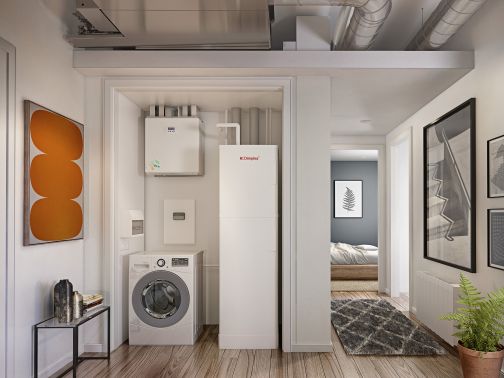How does the Zeroth Energy System address domestic hot water demand and reduce primary energy use in apartments?
Balancing the DHW demand and output
Heating water to the required temperature at the point of use
We will consider how the technology achieves these reductions and what the impact is on modern developments.

How does balancing demand and output increase energy efficiency?
The Zeroth Heat Pump is integrated with a 172l hot water cylinder. This not only means the full solution easily fits into a standard domestic service cupboard, but the hot water cylinder also acts as a thermal store. Once the Zeroth Heat Pump raises the temperature of the ambient water to 55-60oC, it switches off. The water is then kept in the thermal store ready for use. When the available hot water level in the cylinder reduces to approximately 80l the Zeroth Heat Pump tops the cylinder back up to the 172l capacity.
As opposed to heat interface units (HIUs) that tend to offer hot water continuously through the central distribution system, the Zeroth Energy System balances hot water demand and output at source, calling on central plant and its distribution network only when a disbalance occurs. The resulting reduction in primary energy use and carbon emissions benefit the occupiers, developers, and the environment.
What is the impact of heating water at the source on the carbon emission reduction?
The Zeroth Energy System efficiently delivers low carbon heating, hot water, and even comfort cooling in large residential developments by using in-apartment heat pumps connected to an ambient central loop. Compact, water-to-water heat pumps installed in apartments use the water from the ambient loop, designed at 25°C, to raise the in-apartment distribution temperature to the required level for hot water and space heating at the point of demand. This can reduce heat losses throughout the communal network by up to 90% when compared to traditional high temperature distribution systems. Read more on how the innovative in-apartment Zeroth Heat Pumps work here.
To find out how the Zeroth Energy System can help reduce the primary energy demand of a residential building, or to discuss a project in more detail, contact one of our HVAC specialists.








